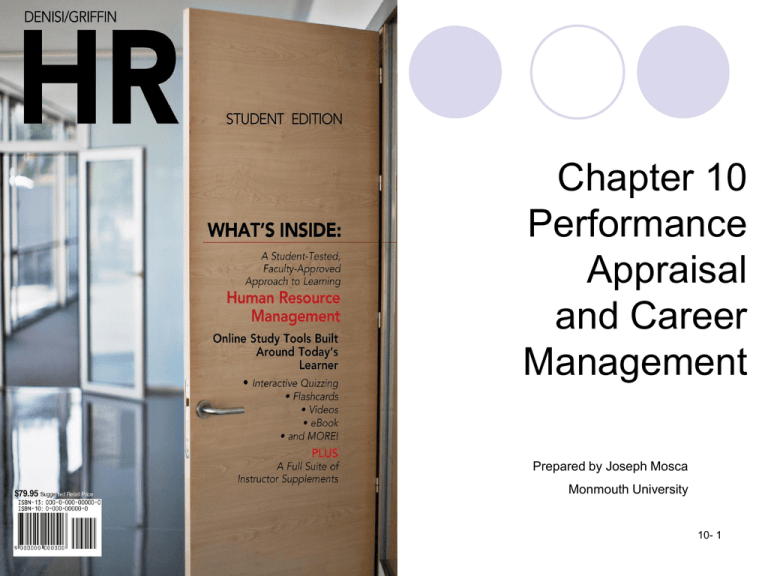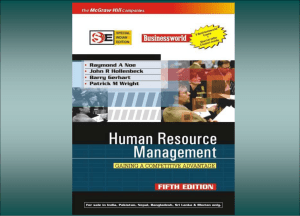
Chapter 10
Performance
Appraisal
and Career
Management
Prepared by Joseph Mosca
Monmouth University
Copyright ©2012 by Cengage Learning. All rights reserved.
10- 1
Learning Objectives
1.
2.
3.
4.
5.
6.
7.
Describe the purpose of performance appraisal in
organizations
Summarize the appraisal process in organizations
Identify and describe the most common methods that
managers use for performance appraisal
Discuss other general issues involving performance
appraisal in organizations
Describe the nature of careers in organizations
Discuss human resource management and career
management
Identify and discuss basic career development issues and
challenges
Copyright ©2012 by Cengage Learning. All rights reserved.
10- 2
Performance Appraisal and
Management
Performance appraisal is the specific
and formal evaluation of an employee
conducted to determine the degree to
which the employee is performing his or
her job effectively.
Performance management is the general
set of activities carried out by the
organization to change (improve)
employee performance.
Copyright ©2012 by Cengage Learning. All rights reserved.
10- 3
The Role of the Rater
The rater is traditionally
and most typically the
supervisor of the
employee being
appraised.
The rater must consider
the context in which
performance occurs so
that any existing
conditions can be taken
into consideration.
Copyright ©2012 by Cengage Learning. All rights reserved.
10- 4
The Role of the Ratee
The one being rated should have a clear
and unbiased view of his or her
performance.
It is essential that both parties have all the
information they can collect about the one
who is being rated and their performance.
This approach should allow the one being
rated to be more receptive.
Copyright ©2012 by Cengage Learning. All rights reserved.
10- 5
360-Degree Feedback
This is an approach to performance
appraisal that involves gathering
performance information from people on
all sides of the manager: above, beside,
below, and so forth.
This approach is potentially helpful,
especially when used for feedback
purposes only.
Copyright ©2012 by Cengage Learning. All rights reserved.
10- 6
Ranking Methods Versus Rating
Methods
The simple ranking method involves having the
manager rank-order, from top to bottom or from
best to worst, each member of a particular work
group or department.
The paired comparison method of performance
appraisal involves comparing each individual
employee with every other individual employee,
one at a time.
The forced distribution method involves
grouping employees into predefined frequencies
of performance ratings.
Copyright ©2012 by Cengage Learning. All rights reserved.
10- 7
Specific Rating Methods
A graphic rating scale consists of a statement
or question about some aspect of an individual’s
job performance.
The critical incident method relies on
instances of especially good or poor
performance on the part of the employee.
Behaviorally Anchored Rating Scales (BARS)
are appraisal systems that represent a
combination of the graphic rating scale and the
critical incident method.
Copyright ©2012 by Cengage Learning. All rights reserved.
10- 8
Specific Rating Methods (con’t)
Behavioral Observation Scales (BOS) are
developed from critical incidents like BARS, but
use substantially more critical incidents to
specifically define all the measures necessary
for effective performance.
A goal-based or management-by-objectives
(MBO) system is based largely on the extent to
which individuals meet their personal
performance objectives.
Copyright ©2012 by Cengage Learning. All rights reserved.
10- 9
Rating Errors
Contrast errors occur when the rater compares people
against one another instead of against an objective
standard.
Distributional errors occur when the rater tends to use
only one part of the rating scale.
A halo error occurs when one positive performance
characteristic causes the manager to rate all other
aspects of performance positively.
A horns error occurs when the
manager downgrades other aspects
of an employee’s performance because
of a single performance dimension.
Copyright ©2012 by Cengage Learning. All rights reserved.
10- 10
Traditional Stages of Careers
Exploration involves identifying interests and
opportunities.
Establishment involves creating a meaningful
and relevant role in the organization.
Maintenance involves optimizing talents or
capabilities.
Disengagement involves gradually beginning
to pull away from work in the organization.
Priorities change and work may become less
important.
Copyright ©2012 by Cengage Learning. All rights reserved.
10- 11
Issues Facing Older Workers and the
Decision to Retire
Copyright ©2012 by Cengage Learning. All rights reserved.
Eventually, older workers must
confront the decision to retire.
More commonly, individuals retire
and then take on
full-time work at other
organizations, or retire and take
on part-time work, or work as a
consultant.
Individuals are likely to retire
when they have the financial
resources needed to maintain
their
pre-retirement lifestyles.
They may also retire when their
health makes work burdensome.
10- 12
Human Resource Management and
Career Management
Most successful organizations and
managers recognize that careers do not
simply happen. Why?
Because careers are managed and
planned, and part of the responsibility for
career planning resides with the
organization.
Copyright ©2012 by Cengage Learning. All rights reserved.
10- 13




